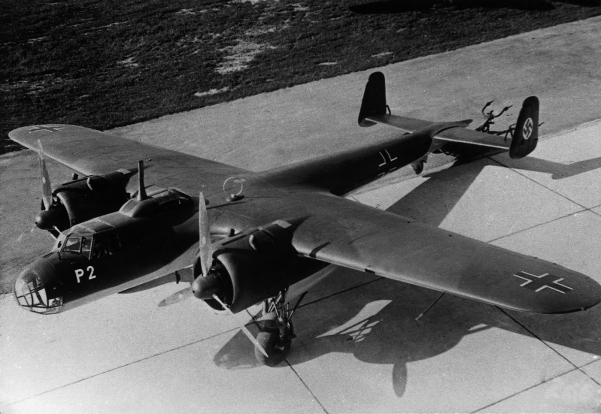
Designed as a fast mailplane (with single-fin tail surfaces) for Deutsche Lufthansa and first flown in 1934, the Do 17 was rejected by the airline and then developed by Dornier as a high-speed bomber with twin vertical tail surfaces. The aircraft entered service in early 1937, gaining the nickname “The Flying Pencil” on account of its slender rear fuselage. The first two military variants were the Do 17E-1 and Do 17F-1 for the high-speed bomber and long-range photo-reconnaissance roles respectively, the latter with additional fuel and the internal bomb bay revised to carry two cameras. The two types offered good performance and adequate all-round capabilities for their day, but by 1939 were obsolescent.
Progressive development led to the Do 17M/P medium bomber/reconnaissance aircraft and Do 17S/U reconnaissance/pathfinder types with liquid-cooled engines and a redesigned forward fuselage. The definitive model was the radial-engined Do 17Z of which 522 were built in three variants: the Do 17Z-1 with a 500kg (1102lb) bomb load, Do 17Z-2 with an uprated powerplant and load, and Do 17Z-3 reconnaissance bomber. Conversions included the Do 17Z-4 dual-control trainer, Do 17Z-5 maritime reconnaissance, Do 17Z-6 long-range night-fighter with the nose of the Ju Ju 88C-2, and Do 17Z-10 night-fighter with a redesigned nose.
Specifications
- Manufacturer
- Dornier-Werke GmbH
- Type
- medium bomber
- Length
- 15.80m (51ft 9.67in)
- Span
- 18.00m (59ft 0.5in)
- Height
- 4.60m (15ft 1in)
- Maximum Speed
- 410km/h (255mph)
- Service Ceiling
- 8200m (26,905ft)
- Range
- 1500km (932 miles)
- Crew
- Four
- Powerplant
- 2 x BMW Bramo radials
- Armament
- 1 or 2 7.92mm MG
- Bomb Load
- 1000kg (2205lb)
- First Flight
- Autumn 1934
- Initial Climb
- Not Available
- Weight (empty)
- 5200kg (11,464lb)
- Weight (loaded)
- 8590kg (18,937lb)
